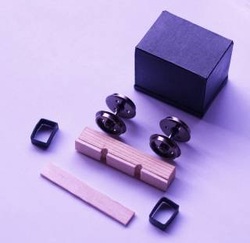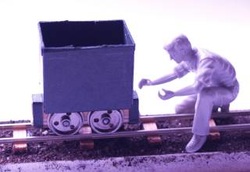Lion tiles. Just how small can you go?
The initial spark for this layout, intended to be a tile kiln, came from a discussion on the Gnatterbox about the minimum gauge used on industrial prototypes. Somewhere we came to the conclusion that tubs as narrow as about eight inch gauge were used in mines where the seams were vertical, just as very low clearances were used for thin, horizontal seams. I remembered the miniature/9mm combination from West Moors and had to have a go at building one, and a short length of track to go with it.
The track and wagon were crude in the extreme in comparison with others' attempts, but I had fun, and putting the fun back into modelling has turned me from an armchair modeller into a builder once again. I also sparked off ideas in some others.
A couple of people from Gnatterbox, who were building Gn15 workshop layouts, added small sections of 9mm track for materials handling, and I built a model of a pushtruck to show how one might look. It used treadplate surfaced styrene sheet, for which I had developed a fondness.
Then the Gnatterbox discussion turned to traversers and shifted, as it often does, this time to transporter wagons. Out came my copy of Sidney Leleux's "Industrial Narrow Gauge Stock and Trackwork", great for when I need inspiration, and lo and behold, there was a wagon onto which smaller brickworks trucks were loaded, to save handling the bricks. Here was the ultimate way of having a traverser in full view.
The image must have been in my mind later that morning as I walked across town to collect a parcel and found a footpath through the intermodal area of the docks. I watched units being loaded onto flat wagons that ran in tight clearances between platforms providing absolutely level access. Fired up, I returned home and built a tiny transporter wagon using an SL100 underframe from Sidelines and some odds of rail and treadplate styrene sheet left over from the pushtruck. It looked surprisingly good, to my eyes at least, so I mocked up a traverser layout. The idea was a kiln, with three tracks, into which had to be sorted six wagons, two to each track in a specific order. This was a variant of a block-sorting puzzle beloved of my late friend David Pritchard, and I was quite pleased with the versatility of the idea.
The track and wagon were crude in the extreme in comparison with others' attempts, but I had fun, and putting the fun back into modelling has turned me from an armchair modeller into a builder once again. I also sparked off ideas in some others.
A couple of people from Gnatterbox, who were building Gn15 workshop layouts, added small sections of 9mm track for materials handling, and I built a model of a pushtruck to show how one might look. It used treadplate surfaced styrene sheet, for which I had developed a fondness.
Then the Gnatterbox discussion turned to traversers and shifted, as it often does, this time to transporter wagons. Out came my copy of Sidney Leleux's "Industrial Narrow Gauge Stock and Trackwork", great for when I need inspiration, and lo and behold, there was a wagon onto which smaller brickworks trucks were loaded, to save handling the bricks. Here was the ultimate way of having a traverser in full view.
The image must have been in my mind later that morning as I walked across town to collect a parcel and found a footpath through the intermodal area of the docks. I watched units being loaded onto flat wagons that ran in tight clearances between platforms providing absolutely level access. Fired up, I returned home and built a tiny transporter wagon using an SL100 underframe from Sidelines and some odds of rail and treadplate styrene sheet left over from the pushtruck. It looked surprisingly good, to my eyes at least, so I mocked up a traverser layout. The idea was a kiln, with three tracks, into which had to be sorted six wagons, two to each track in a specific order. This was a variant of a block-sorting puzzle beloved of my late friend David Pritchard, and I was quite pleased with the versatility of the idea.


